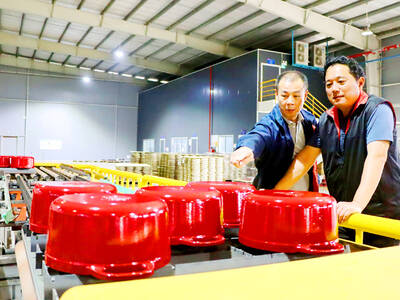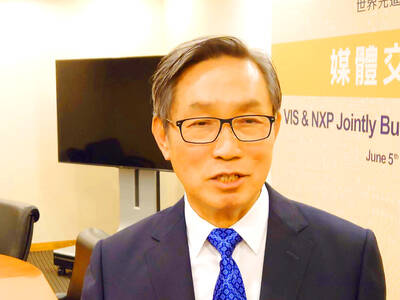Asahi Glass Co of Japan, the world's second-largest thin-film transistor liquid-crystal display (TFT-LCD) glass-substrate maker, may plan to expand investment in Taiwan to meet rising flat-panel demand, Science Park Administration officials said yesterday.
"Asahi is considering establishing plants by renting the entire Yunlin base of the Central Taiwan Science Park, a total of 97 hectares," said Wang Hong-yan (
"The company may not make a decision until July or August, after the board's election," Wang said. "But if the company approves the new investment, it may invest up to NT$500 billion in the park's Yunlin base."
Asahi had sales of about ?1.29 trillion last year, an increase of around 2.5 percent from a year ago. Its income last year grew about 27.6 percent to ?56.8 billion.
The Japanese company began its Taiwanese operations in 2000 by setting up the wholly-owned Asahi Glass Fine Techno Taiwan Co (
Asahi Glass has an annual production capacity of 14,000,000m2 of TFT-LCD glass substrates. The company hopes to finalize its construction by 2005 and boost its global market share to around 45 percent, behind Corning Inc of the US with 50 percent.
The Central Taiwan Science Park totals 430 hectares with 333 hectares in Taichung and the rest in Yunlin. The park was inaugurated in October 2002, and has attracted 38 enterprises, mostly optical-electronics and precision machinery industries.
Total investment attracted amounts to NT$430 billion, including AU Optronics Corp's (
The Science Park Administration expects the park to create an output value of NT$100 billion next year and NT$120 billion after three years.
"Central Taiwan's park, which has boosted the value of Taichung's real estate by 10 to 30 percent, would offer 50,000 jobs, further helping central Taiwan's economic development," said Yang Wen-ke (
Hsinchu Science Park, the nation's high-tech cradle, last year also enjoyed large-scale growth in revenue, thanks to the recovery of the global semiconductor industry.
"The Hsinchu park's 2003 revenue reached NT$857.8 billion, a leap of 22 percent compared to 2002 [revenue]," said Randy Yeh (
The industries that saw a big increase in revenue include optical-electronics with a 57 percent rise, biotechnology with a 30 percent gain and IC makers with 24 percent growth.
The Hsinchu park also attracted 54 new companies with a total investment of NT$31.9 billion last year, an increase of 15 percent over the previous year.
The boom that began in the third quarter of last year has helped the Hsinchu park's exports to grow by 40 percent to NT$390.8 billion while its imports dropped 11 percent, to NT$221.8 billion, because of companies' reluctance to add equipment after slow business in the previous year.
The Science Park Administration is upbeat about the Hsinchu park's outlook this year.
"In view of the continuing prosperity of the global semiconductor industry, the domestic IC industry could enjoy a growth rate of 31 percent," Yeh said. "The park's revenue is expected to rise by 28 percent to NT$1.1 trillion this year."

TARIFFS: The global ‘panic atmosphere remains strong,’ and foreign investors have continued to sell their holdings since the start of the year, the Ministry of Finance said The government yesterday authorized the activation of its NT$500 billion (US$15.15 billion) National Stabilization Fund (NSF) to prop up the local stock market after two days of sharp falls in reaction to US President Donald Trump’s new import tariffs. The Ministry of Finance said in a statement after the market close that the steering committee of the fund had been given the go-ahead to intervene in the market to bolster Taiwanese shares in a time of crisis. The fund has been authorized to use its assets “to carry out market stabilization tasks as appropriate to maintain the stability of Taiwan’s

STEEP DECLINE: Yesterday’s drop was the third-steepest in its history, the steepest being Monday’s drop in the wake of the tariff announcement on Wednesday last week Taiwanese stocks continued their heavy sell-off yesterday, as concerns over US tariffs and unwinding of leveraged bets weighed on the market. The benchmark TAIEX plunged 1,068.19 points, or 5.79 percent, to 17,391.76, notching the biggest drop among Asian peers as it hit a 15-month low. The decline came even after the government on late Tuesday authorized the NT$500 billion (US$15.2 billion) National Stabilization Fund (國安基金) to step in to buoy the market amid investors’ worries over tariffs imposed by US President Donald Trump. Yesterday’s decline was the third-steepest in its history, trailing only the declines of 2,065.87 points on Monday and

TAKING STOCK: A Taiwanese cookware firm in Vietnam urged customers to assess inventory or place orders early so shipments can reach the US while tariffs are paused Taiwanese businesses in Vietnam are exploring alternatives after the White House imposed a 46 percent import duty on Vietnamese goods, following US President Donald Trump’s announcement of “reciprocal” tariffs on the US’ trading partners. Lo Shih-liang (羅世良), chairman of Brico Industry Co (裕茂工業), a Taiwanese company that manufactures cast iron cookware and stove components in Vietnam, said that more than 40 percent of his business was tied to the US market, describing the constant US policy shifts as an emotional roller coaster. “I work during the day and stay up all night watching the news. I’ve been following US news until 3am

TARIFF CONCERNS: The chipmaker cited global uncertainty from US tariffs and a weakening economic outlook, but said its Singapore expansion remains on track Vanguard International Semiconductor Corp (世界先進), a foundry service provider specializing in producing power management and display driver chips, yesterday withdrew its full-year revenue projection of moderate growth for this year, as escalating US tariff tensions raised uncertainty and concern about a potential economic recession. The Hsinchu-based chipmaker in February said revenues this year would grow mildly from last year based on improving supply chain inventory levels and market demand. At the time, it also anticipated gradual quarter revenue growth. However, the US’ sweeping tariff policy has upended the industry’s supply chains and weakened economic prospects for the world economy, it said. “Now